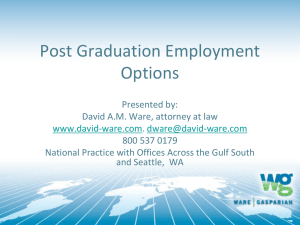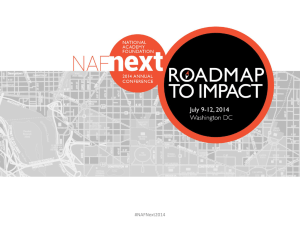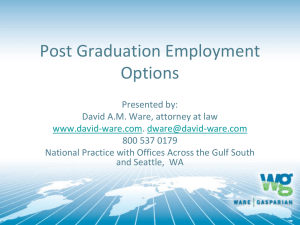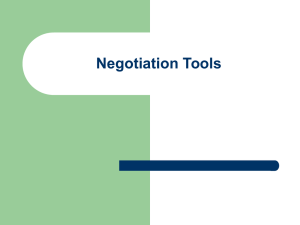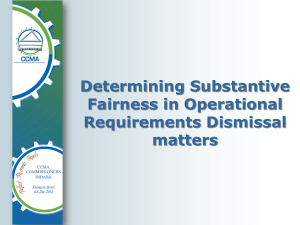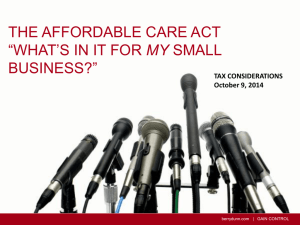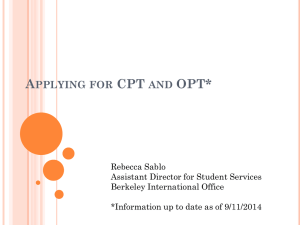Post Graduation Employment Options: Clearing All the Hurdles
advertisement
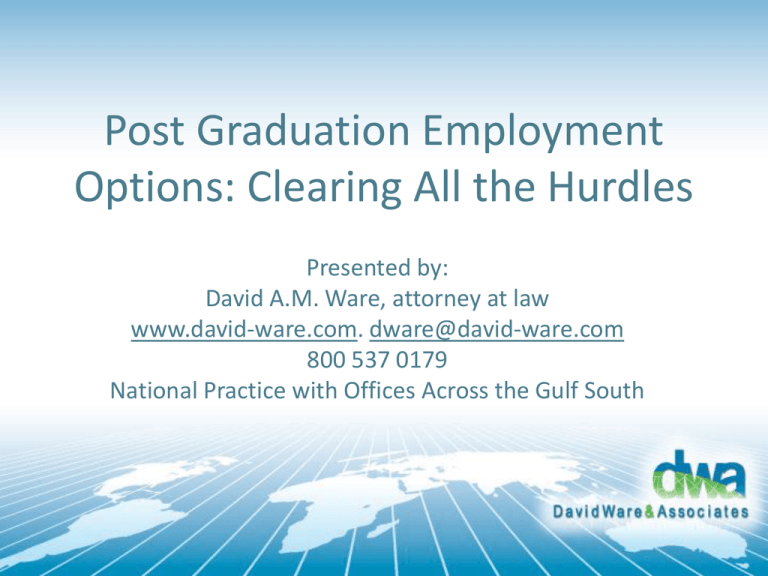
Post Graduation Employment Options: Clearing All the Hurdles Presented by: David A.M. Ware, attorney at law www.david-ware.com. dware@david-ware.com 800 537 0179 National Practice with Offices Across the Gulf South Where Do I Start? • Your career in the US after graduation should ALWAYS start with Optional Practical Training (OPT). OPT ideally acts as a bridge between your studies and the workplace. • It allows you to “get your foot in the door” with a US employer without any paperwork on their part: vitally important. • It allows you to try more than one job if you wish. Can I Skip A Step? • While in some cases it may be possible to proceed directly to H1B or even permanent residence without OPT, this is usually unadvisable, as the H1B could be denied, and permanent residence almost always takes more than one year. Cross The Bridge • You must apply within the 90 days before completing your program or up to 60 days after completion. • Apply early and follow school’s instructions: all OPT must end within 14 months of program end date. • Thus if you apply after completion, you may get less than one year OPT! How Do I Cross? – Eligible for one year of OPT for each higher degree • Don’t need job offer to apply • Employment must be directly related to major field of study • Apply by filing Form I-765 with USCIS with OPT I 20 – Apply no more than 30 days after ISA authorizes in SEVIS Grab onto the STEM! – STEM extension of OPT • Students who earn bachelor’s or higher in a science, technology, engineering or mathematics (STEM) field may receive one 17-month extension, for 29 months total OPT – Apply by filing Form I-765 before initial 12 months of OPT expires » Authorized to continue working 180 days while waiting for approval – Employer must enroll in E-verify » See www.uscis.gov/E-Verify » Many already enrolled, required by law in some states, but some may refuse, so discuss with employer While On OPT • While engaged in OPT, you must report change of your name, address, or e-mail address, change of employer’s name or address, loss of job, and changes of employer to your advisor. Failure to do so could result in denial of H1B, PR. Also, “validation report” each six months if on STEM ext. Your school must report any changes in SEVIS. Your employer must report if you are on STEM ext. and lose your job. The Bridge Stops Here Unemployment may lead to violation of status • Allowed 90 days unemployment during initial period of OPT • Those with STEM extension allowed cumulative total of 120 days of unemployment during initial and extension period • SEVP says paid or unpaid employment of at least 20 hours per week suffices, even on STEM, and may be with more than one employer. SEVP 4/23/10. Volunteer! • SEVP says self-employment, independent contractor work, or through agency or consulting firm are acceptable, but not on STEM. • No grace period between jobs. SEVP 4/23/10 • Time outside U.S. does not count as unemployment if you are employed before leaving U.S. • This is current guidance from SEVP and could change, so get advice from your International Office! The Next Step: H1B • H1B is the principal immigration status available for persons temporarily working in professional level jobs (“specialty occupations”) in the US. • Who sponsors? www.immihelp.com/hibsponsoring-companies-database/ • It generally requires that the employee have at least a four year degree or equivalent AND that the position require a minimum of a bachelor’s degree. • So, for example, engineer, accountant, yes; store clerk, cook, secretary, no. What Are the Other Parameters of the H1B? • Employment is limited to the employer(s) who petition(s) for the student. May hold more than one H1B at same time. H1B may be part time. • Employment is generally limited to six years with ALL employers (unless employment-based permanent residence begun by end of 5th year). • Employment must be directly related to degree program— either current program or any prior degree program. • H1B’s are limited by strict fiscal year quotas. Federal FY = 10/1 to 9/30. • The H1B beneficiary may have “dual intent”. What Are the Employer’s Obligations? • Must agree to employ beneficiary as set out in the petition (no fraud!). • Must need the services of the employee (no uncles with corner stores!). Employer’s Wage Obligation • Must agree to pay higher of actual or prevailing wage (aka “required wage”). – Actual wage: wage paid to other similarly employed and similarly qualified workers at same worksite. – Prevailing wage: weighted mean or median wages for similar positions in geographic area of employment. – Basically, this means that a competitive wage must be offered. – There are four levels of wages and separate wage data for higher ed and certain other employers. See: • www.flcdatacenter.com/oeswizardstart.aspx Employer’s Obligations? • Must agree to employ H1B only in geographic location(s) set out in labor condition application. • Must agree to pay return transportation to country of nationality if H1B terminated before end of visa petition approval (but not enforceable). Employer’s Obligations? • Must be no strike or lockout (unionized jobs). • Must notify other workers of terms of job (two 10 day postings or letter to union). • Must agree to pay certain fees to USCIS (next slide). • These fees changed on November 23, 2010 (see green for changes). What Are the Fees? • • • • • • Regular filing fee: $320/$325* Filing fee for dependants: $300/$290* Premium fee: $1000/$1225* Fraud fee: $500/no change* ACWIA fee: $1500 or $750/no change* Attorney’s fees: vary widely: no standard amount. *Change in fee amounts effective November 23,2010 Who Pays for What? • Except for ACWIA fee, there is no hard and fast rule. • Usually larger companies are more willing to pay. • May depend on your bargaining power (your skill set, employer need). • The employee may pay everything except the ACWIA fee, unless: – Paying any or all of the fees would push the employee below the “required” wage. Who Pays: An Example • Shiva is offered $46K as a mechanical engineer. • The prevailing wage (level 1) is $42K for the county where he is to work. • www.flcdatacenter.com/oeswizardstart.aspx • Employer pays the ACWIA fee; wants Shiva to pay attorney’s and other fees (total $5K). Can he? What’s Filed and When? • First is Labor Condition Application. Filed electronically with Department of Labor. Takes about five to ten business days to be approved. • Next is H1B Petition, together with LCA, evidence of qualifications, and description of job, filed at either VT or CA Service Center of USCIS, depending on place of employment, or CA if quota exempt. • If employee maintaining lawful status in US, status is changed to H1B, along with family members. • If outside US, or traveling following change of status, must obtain H1B visa at US consulate, unless going for 30 days or less to Canada/Mexico. The Magic Approval • Processing of the H generally takes three to seven months. Fifteen day premium processing is available for $1,225; PP also guarantees easier communication with USCIS via phone/email. • Once approved, the H employee may “port” to a new employer once that employer files a new petition. Approval of new petition is not necessary to “port”. BEWARE: “porting” is difficult if you have not been counted against the quota. Any Pitfalls? • Horrible quota problems in prior years! – Currently H1B’s are limited to about 78,200 per fiscal year. ~58,200 for those with no US earned Master’s. --20,000 for those with US earned Master’s or higher. ~6,800 reserved for H1B1 for citizens of Chile, Singapore. Quota Statistics • In 2008, USCIS accepted H petitions for five business days beginning April 1 and all cases received put into a lottery. • All 78,200 numbers were exhausted. • In 2009: same system, but about 20,000 visas left at end of process. • Both regular and Master’s quotas exhausted 12/21/09. • New quota opened on 4/1/10. On December 24, 2010 the Master’s quota was met and by January 26, 2011 the regular quota was met as well. • The FY 2012 quota opened April 1, for employment to begin October 1, 2011. • So far 5900 Regular and 4500 Master’s used. So Called “cap gap” OPT • In order to assist students caught by the H1B quota, USCIS in April 2008, created so called “cap gap” protection which automatically extends OPT and DS through September 30 of any year, if: – The student’s employer properly filed an H1B petition on his/her behalf prior to the expiration of his/her OPT (which must end on or after April 1); – The H1B petition shows a start date of October 1. – Cap gap OPT ends midnight September 30. • In order to fully document the “cap gap”, the student should seek a “cap gap” I 20 from the school. Travel While In “Cap Gap” • You should not travel while in the cap gap as you will have no valid EAD card. Reentry to the US on OPT generally requires: – I 20 endorsed for travel – Valid passport and F 1 visa (unless visa exempt) – Valid EAD card – Employment letter Cap Gap Example • Maria’s OPT ends May 15, 2011. • Her employer files an H petition for her on May 1, with a start date of October 1 (the earliest date that can be requested). • The H is pending, but not approved, until, September 15 (it MUST be adjudicated by September 30). • Maria’s F status and OPT will automatically be extended to midnight, September 30. • She may (but does not have to) request a “cap gap” I 20 from her school. Who’s Exempt from Quota? • Exempt from the quota are – Persons already counted against it within past six years. – persons who work in higher ed and affiliated nonprofit entities. – Those who work “at” rather than for a quota exempt employer – Employees of non profit research and government research organizations. – J 1 physicians granted a waiver of the two year home residence requirement under “Conrad” program. – Persons engaged in concurrent quota exempt/quota subject jobs also exempt. – Note that most govt. entities and non profits are NOT exempt from quotas. Careful, Careful • Many beginning positions in business and IT do not require a degree: eg, sales, management trainee slots, data entry operator. • Many entry level jobs pay partly or solely on commission. Commission or sales bonuses generally cannot be included in the wage computation. • Beware of “make work” or make believe jobs from friends or relatives. Pay stubs, W 2’s will be required when you go abroad for visa issuance, apply for future immigration benefits! • Also beware of fly-by-night companies which may “bench” you until they place you in a job. • Paying a company to file for you when you have no intention of working for them is FRAUD—can jeopardize your future in the US. • Startups, financially troubled businesses, and those that take a tax loss each year will NOT be able to sponsor for permanent residence! Does This Job Really Require a Degree? • Complexity of job:Does the job require the application of theoretical and practical knowledge typically acquired in a relevant four year degree program? • Employer reqts: Has the employer consistently required a minimum of a Bachelor’s in particular major(s) for position? Or is the requirement simply an employer preference? Or is the employer simply making up the requirement to get you an H1B? • Other, similar: What are industry standards for this type of job? Check ads on internet, DOL’s Occupational Outlook Handbook. • $$$$: Is the salary commensurate with a professional-level position? Employers’ Many Misconceptions • Employer believes that it must recruit, prove American workers not available, or prove that student is exceptional, special, or unique in order to sponsor. • FALSE: No recruitment required. Special qualities not required. Two ten day postings or letter to union are for notification only. Misconceptions—Trouble, Money • Employer thinks the process “will get them in trouble with immigration” (not unless they have otherwise shady practices or lie in the paperwork). • Employer doesn’t want to reveal financial information to USCIS: in the H1B context financial info almost never needed. If so, does not have to be revealed to employee. • Employer thinks they have to pay legal fees (not unless this would push employee below required wage). Misconceptions--Paperwork, Money, Americans • Employer thinks “it’s too much trouble, paperwork” (a few signatures, two ten day postings, no advertising; attorney can simplify process). • Employer worries about posting the employee’s wage (post a range!). • Employer feels they receive enough resumes from US workers; no need to apply for a foreigner (didn’t they ever hear of the immigrant work ethic?; try to identify immigrants within the company). Misconceptions—”Contract”? • Employer worries that sponsorship may constitute contract of employment (no, but if they’re worried, do a memo of understanding both sign). • Employer worries that employee is later going to ask for PR and leave the company –they’ve been burned before (Sign a “one way” contract; employee has to repay legal fees if leaves before a certain date; but employer retains right to “employ at will”). Misconceptions—Who Pays • Employer doesn’t want to pay ACWIA and fraud fees and wants employee to pay them. – There are penalties for employee payment of ACWIA fee. – No apparent penalty for employee paying fraud fee. • These fees are less than what the employer would pay a recruiter. • Remember, you can’t pay fees that would push your wage below the “required” wage. Misconceptions—Lower Salary • Employer doesn’t want to pay required wage and wants to have “side deal” with employee to pay less or pay part in commissions/bonuses. – There are severe penalties, including back pay, fines up to $5000 per incident, and prohibition from petitioning for any employment based nonimmigrant/immigrant for up to two years for this practice. – Pay stubs, W 2’s are often requested at visa interviews, and in connection with applications for immigration benefits. What About Starting My Own Business? • To be an H1B employer, an entity usually must have at least one employee other than the H1B. Very difficult to get a “self employed” H petition approved. • Usually not a wise idea to start your own business, unless you have loads of money (at least 500K to 1 million) or qualify for investor visa (treaty required). • Why not? Generally, business owners cannot sponsor themselves for permanent residence. • Consider E or L instead of H (see below). Are There Alternatives to the H? • TN (Treaty NAFTA) for citizens of Canada and Mexico only. Occupations listed at 8 Code of Federal Regulations Sec. 214.6(c) mostly require a minimum of Bachelor’s degree. But MBA’s beware: “Management Consultant” is carefully scrutinized; generally must be independent contractor. TN given in three year increments; requires residence abroad (no dual intent). Other Alternatives? • H1B1 visa for Chile, Singapore: very similar to normal H1B, except granted in one year increments, requires residence abroad (no dual intent). • E 3 for Australian citizens; again very similar to H1B; two year increments; minimum Bachelor’s, dual intent ok; spouses may work. • H-3 trainee. 2 yrs max; training must be for job abroad. • J-1 trainee. 18 mo. max; looser than H 3, but many J sponsors will not sponsor if you are in US. • J-1 professor/researcher or K-12 teacher. • O-1 alien of extraordinary ability/achievement. H Alternatives? • E 1/E 2: if your country of nationality has an trader/investor treaty with US, investment of as little as 50K in a job-creating business can mean a visa for life, work permit for spouse. • L 1A/L 1B: if you were employed by a company abroad for at least a year before coming to the US, and they wish to employ you in US; work permit for spouse. • R-1: possible if job offer has a significant religious component. • B-1 business visitor: only possible if employed outside US, no remuneration in US except expenses, and product/service is made/rendered outside US. VERY LIMITED UTILITY. What If No Job Offer in US? • Go back to school, retool your skills to fit the market. • Canada, Australia or other country with demand for your skills are alternatives. • Canada has an easy point system. See cic.gc.ca • Your home country or other country where your language is spoken/your skills are in demand. Many companies, eg, Johnson and Johnson, eagerly hire for home country service, and then often transfer back to the US. Routes to Permanent Residence • Employment-based • Family-based – U.S. citizen or permanent resident spouse – USC or PR parent; USC child over 21; USC sibling – Long waits for all but spouse of USC or parent of USC child over 21. • • • • • • • Asylum Diversity Visa Lottery: only apply at www.travel.state.gov Large Investment Domestic Abuse Victims of Trafficking and Serious Crimes Special Programs Removal Proceedings Permanent Residence Myths • There is no such thing as “sponsorship” for permanent residence by a friend, someone with “connections”, or distant relative. • Congressmen can help with PR only by sponsoring a “private bill” in the most extreme situations where no legal remedy exists. Very rare! Otherwise, only can help if case “stuck”. • Other influential community members generally cannot help. • Adoption does not confer immigration benefit unless completed while under age 16. Permanent Residence Myths • The mere accrual of time spent in the US generally does not result in PR. • Sponsorship by an employer or most family members does not generally result in an automatic right to remain in the US while sponsorship is ongoing; person must have independent nonimmigrant status, eg, F 1, H1B. • Hardship, standing alone, is not a basis for PR. • Country of origin is largely irrelevant in PR process. Permanent Residence Myths • Two year home residence requirement never just “disappears”, eg, diversity lottery winners. • Research grantor, eg, NIH, usually has no interest in PR process. • “My friend” got a green card in two weeks (mysteriously). • Fake marriages work; my friend did it! • Marriage to a USC results in immediate citizenship or benefits. • Having a baby in the US leads to PR (yes, in 21 years). The Importance of Maintaining Status • Merely filing an I 130 or I 140, or labor certification does not confer lawful status. • The person must separately maintain some lawful status if in the US while waiting for PR. • For students and scholars, very important to do so, as things may change while waiting (petitioner may die or divorce, job may vanish) • Important to apply for work authorization and advance parole as soon as eligible. “Dead End” Courses of Study • Students and scholars whose long term goal is permanent residence should be advised that certain courses of study will not help them reach that goal. While this is a complex area best suited to experts in a career services office, general guideposts may be offered. “Dead End” Courses of Study • Study in a field which requires less than a Bachelor’s degree, eg, Auto Mechanics, and/or attainment of less than a Bachelor’s degree in any field. • This includes most persons studying Nursing. • Why “dead end”? Because general work visa (H1B) is not available, PR takes many years, and student must be able to work for employer and maintain status while waiting for PR. “Dead End” Courses of Study • Bachelor’s degree programs where employment opportunities are very limited, or entry into the field not possible with Bachelor’s degree, eg, most humanities programs, most social sciences. • Programs where there is a huge oversupply of US workers, eg, law (JD or LLM). Employment Based Immigration • Generally must have full time permanent job offer. Only exceptions, National Interest Waiver, Alien of Extraordinary Ability. • First step is generally labor certification. Only NIW, Extraordinary Ability, Outstanding Professor/Researcher, Aliens of Exceptional Ability, Nurses, PT’s can avoid LC. • LC requires employer to test the labor market, prove it can’t find US workers, through highly structured recruitment process. Employment-Based PR--Steps 1. Labor certification • Employer advertises position to “test the labor market” – Several forms of advertisement required • Employer files application through PERM system (online) • DOL approves, denies, or audits • Employer must pay attorney’s fees and ad costs. 2. Employer files immigrant petition (I-140) with USCIS 3. Employee files Adjustment of Status Application (I-485) with USCIS • Must have current “priority date” on Visa Bulletin to file – Some categories/countries backlogged, queues of several years • If “current,” may file petition and application together (“concurrent filing”) • Can apply for EAD and advance parole “travel document” with adjustment application • Spouse and unmarried minor children can file AOS at same time. 4. During entire process employee must maintain valid nonimmigrant status. Finding an Immigration Attorney • Discuss with your employer • Ask friends, your school, and others for references • Probably a good idea to beware of those who – Claim to be experts in immigration and other areas (divorce, injuries, etc.) – Have little or no experience with students or exchange visitors (you are subject to complex rules) – Offer a guaranteed result or offer to charge you only if they are successful – Will not agree to a “flat fee” (unless your case is unusual or complex) – Are not familiar to anyone else, especially your advisor – Are unusually cheap or promise results different from other lawyers you consult – Who ask you to sign things that are not true, or without reading them first (fraud carries permanent and possibly criminal penalties) – Who don’t call you back or don’t send you copies of their work on your behalf – Are of interest to you only because they speak your language or are from your country – Are of interest to you only because they have an office near you QUESTIONS? ¿Preguntas? Domande? Fragen? Qüestiós? Vragen? Perguntas? Cau hoi? Kum tum? Post Graduate Employment Options: Clearing All The Hurdles Presented by: David A.M. Ware, attorney at law www.david-ware.com. dware@david-ware.com 800 537 0179 National Practice with Offices Across the Gulf South

